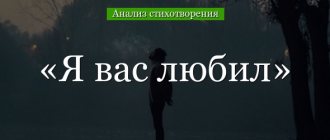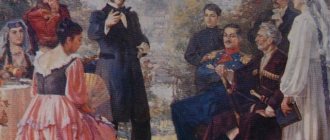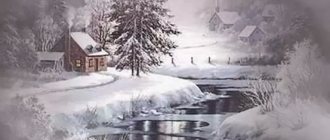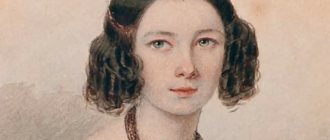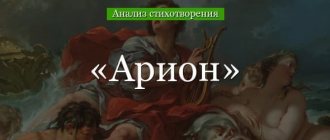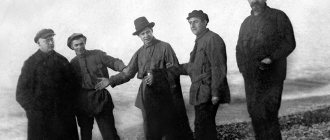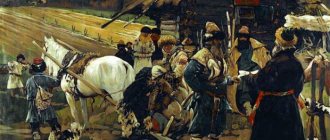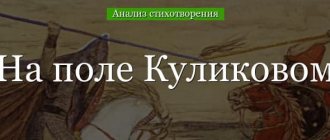History of creation
The history of the creation of Pushkin’s poem “Anchar” is very unusual.
Undoubtedly, the author was inspired to write the work by two literary sources. The first is an ancient legend that tells of a highly poisonous tree. The second is the scientific works of Dr. Fouche.
In his treatise, he talked about a tree that grows only on the island of Java. This semi-legendary plant is completely poisonous, from roots to leaves.
It was to him that the leaders sent criminals sentenced to death. The doomed brought poison, and they themselves died painfully. Having received the coveted poison, the leaders smeared their arrows with it and defeated their enemies.
It is obvious that Alexander Sergeevich took these stories as a basis, but filled them with a purely personal meaning.
The poem was born in 1828 , two years after exile to Mikhailovskoye.
By this time, the poet was already convinced that he would not see the desired freedom of creativity. The government and censorship banned poems, Pushkin felt oppressed and sad.
In this mood, a poem was born, clearly showing the arbitrariness, inflexibility and pressure of power. It is allegorical and deeply symbolic.
Brief Analysis
Before reading this analysis, we recommend that you familiarize yourself with Anchar’s poem.
The history of the creation of the poem - it was written in 1828, when two years had passed since Pushkin was allowed to return from exile. It became clear to the poet that his ideas about creativity without restrictions were not destined to come true, and he poured out his sadness in the text of this work.
The theme of the poem is the destruction of power, which has no limits. Pushkin experienced the power of this phenomenon himself, which made the poem unusually convincing and emotionally deep.
The composition - the work consists of two parts: the first talks about a tree exuding poison, the second - about a man who, obeying the order of his master, brought “deadly resin” and died, himself poisoned by it.
Genre : lyrical poem with ballad elements.
The poetic meter is iambic tetrameter.
Metaphors - “the nature of the thirsty steppes gave birth to it on the day of wrath,” “a black whirlwind will run into the tree of death,” “it obediently flowed on its way.”
Epithets – “in the desert stunted and stingy”, “dead greenery”, “thick transparent resin”.
Comparisons – “anchar, like a formidable sentry.”
Inversions – “dead green”, “thick transparent resin”, “black whirlwind”.
Subjects
The main theme of the work is unrighteous power, which gives rise to terrible evil.
Nothing living touches the anchar, understanding the danger of such contact. However, one person is sent to the tree by another person with authority. The subordinate cannot object to anything, goes on a journey, brings poison and dies.
So Pushkin shows that it is the unjust power, which is allowed everything, that is the most terrible evil, and not at all the anchar, whom nature created this way.
Means of expression
The poet used all the richness of the Russian language to convey both the psychological and ideological message of the poem. Thus, the following artistic means were used in its creation:
- metaphors - “the nature of the thirsty steppes gave birth to it on the day of wrath”, “a black whirlwind will run onto the tree of death”, “obediently it flowed on its way”
- epithets - “stunted and stingy in the desert”, “dead greenery”, “thick transparent resin”
- comparisons – “anchar, like a formidable sentry”;
- inversions – “dead green”, “black whirlwind”
.
.
.
It is also easy to trace the antithesis “king - slave” in it. To create it, the author uses not only epithets (“poor slave” - “invincible ruler”), but also verbal opposition: if the king sent a slave, then he flowed, and in the second case the verb is strengthened by the word “obediently”. At the same time, the king and the anchar, on the contrary, are described as equally deadly phenomena.
With the help of bright expressive means, Pushkin created a dark, emotionally rich work with a clearly expressed thought.
Pathos
In the poem one can hear bitterness and dissatisfaction with the current situation.
However, Pushkin does not appear here as an ardent fighter, an angry messenger of truth. No, he's just talking bitterly about unrighteousness. One feels that the poet is tired and somewhere in his soul he has almost resigned himself to the position of an eternal exile.
Likewise, the hero of the work does not complain, but obediently goes and brings poison, although he knows that he will die.
One gets the bitter feeling that the author has matured and realized the futility of active confrontation. This is not surprising, because by that time Pushkin had already been in exile twice, survived the punishment of his Decembrist friends, and more than once encountered censorship that did not allow his works to proceed.
Image system
The poem contains few vivid images:
- poisonous tree anchar,
- powerful ruler
- humble servant.
First, the author paints a dangerous plant in all colors. Nothing living touches it. However, the anchar itself is not so terrible, because if you do not contact it, then nothing will happen.
The only danger comes from the wind, which carries toxic fumes, but this is an inanimate element with which it is impossible to compete.
In fact, anchar is not evil incarnate, it’s just that nature itself made it that way, which calmly avoids death without coming into contact with the tree.
On the other side is the ruler, who personifies any power at all. He knows how dangerous the tree is, but he sends a servant to him, instructing him to bring poison for the arrows at all costs.
The doomed man cannot object - and goes to carry out the terrible order.
Thus, Pushkin shows the destructiveness of an unrighteous government that allows everything. It even contradicts common sense and the laws of nature.
A similar thought can be heard in many of Pushkin’s works, for example, in the youthful ode “Liberty,” colored by completely different emotions.
Lesson summary “Analysis of the poem by A.S. Pushkin "Anchar"
“Analysis of the poem by A.S. Pushkin "Anchar" 9th grade
Lesson objectives:
- Learning objective:
training in analysis of poetic text; to teach students to understand the poetic word, to notice its semantic shades, to lead students to understand the meaning of the poem, directed against the unlimited power of man over man.
- Developmental goal:
development of oral speech, skills and abilities of observation, comparison and comparison.
- Educational goal:
to cultivate the moral qualities of students; cultivate a love of poetry; arouse interest in the work of A.S. Pushkin.
During the classes
1. Org. moment.
Greetings. Setting the topic, goals and objectives of the lesson.
2. New material.
U.: One of the most important themes of Pushkin’s lyrics is the theme of freedom. Freedom for Pushkin is the highest value in life; without it, in his youth, he could not imagine his existence. Freedom is the basis of friendship, a condition for creativity. Life without freedom took on dark and ominous tones. Ideas about freedom have always been the basis of Pushkin’s worldview.
— How do you understand what freedom is?
—What word would you use to describe the state opposite to freedom?
—What feelings do you think a slave should feel?
— The pinnacle of Pushkin’s freedom-loving lyrics can be considered the poem “Anchar”
3. Text analysis.
The history of the creation of the poem.
— The draft manuscript of “Anchara” has the exact date of writing: “November 9. 1828. Raspberries”, and was first published in 1832 in the almanac “Northern Flowers”.
In the last stanza, instead of “prince”, “tsar” was printed, which aroused suspicion in the presence of allegory in the work from the head of the III Benckendorff Department, and Pushkin had to give an explanation. The chief of gendarmes asked Pushkin to answer how this poem could have appeared without the tsar’s permission.
The work is based on the legend of the deadly anchar tree, mentions of which appeared at the end of the 18th - beginning of the 19th centuries. A number of publications of those years reported that in the east they smeared weapons with Anchar poison, risking their lives in obtaining this poison. The legend became widespread in Russia. Not long before Pushkin, the famous poet of that time P. Katenin wrote the poem “Regret,” in which the image of the “tree of life” was drawn, symbolizing “the king’s mercy.” Researchers of Pushkin’s work put forward the version that the poet created his poem about the “tree of death” as an antithesis to Katenin’s image.
U.:
— There was an epigraph in the manuscript:
The epigraph is taken from Coleridge’s tragedy “Repentance” (Act I, Rev. 1).
The translation goes like this:
“Here is the tree of poison; pierced to the core, It cries only poisonous tears.” Coleridge. (English)
— Why do you think the poet turned to this plot?
A recording of the poem “Anchar” is played
Genre and composition of the poem.
U.: - “Anchar” is a plot sketch based on a legend, with philosophical issues that correspond to the genre of parable. The composition allows you to follow the development of the author's idea and is built on the basis of an antithesis. Story sketch
- a work built on the succession of plot events and experiences of the lyrical hero.
The plot
is the factual side of the narrative, those events, incidents, actions, states in their causal and chronological sequence, which are assembled and formalized by the author on the basis of the patterns perceived by the author in the development of the depicted phenomena.
Legend
is a poetic legend about a historical or heroic event.
A parable
is a short story containing a lesson in an allegorical form.
— How many parts can a poem be divided into?
— What is said in each part?
- Title parts of the poem with terms from it.
- Prove that the poem is built on the basis of an antithesis.
The main themes and ideas of the poem.
U.: - The main theme of the poem is world evil, which is viewed from both a philosophical and social point of view. Pushkin paints the image of evil as an eternal problem of human existence on earth. Its symbol becomes the “tree of death” - anchar. The philosophical problem of life and death correlates with it. At the same time, the poet addresses in this poem the most important theme that runs through all of his work - the theme of freedom and tyranny, but reveals it in a general philosophical sense, which was characteristic of his poetry of his mature period. In “Anchar” Pushkin presents his view of the system where there is unlimited power of one person (prince or king) over another. The poet sees in its very essence the source of evil and reveals this important idea throughout the course of the poem
The figurative system of the poem. Work with text. 1 part.
U.: - Find the key images of nature depicted in the first part of the poem. Write them down in your notebook in the form of a diagram:
— Check your entries:
— How do we see these images in Pushkin? Find the epithets that characterize them and write them down in your notebook.
- Let's check your notes.
- How do we see the desert in Pushkin?
—What does the poet say about the soil? Pushkin creates an image that is completely opposite to what we often see in folk poetry, where the earth is called “Mother - the damp earth.”
— What do we learn about the steppes?
— What epithet does Pushkin choose for the word “day”?
— What does the word “green” mean? The combination “dead greens” is perceived as a violation of the norms of nature. The expression “dead greens” contains an oxymoron, i.e. an epithet that connects the incompatible
— How do we see sand in the poem?
— Name the Elements of Nature that, when they come into contact with Anchar, become destructive. The wind, colliding with the tree of death, receives the terrible name “black whirlwind” and, flying past it, becomes the bearer of evil.
... only a black whirlwind will run onto the tree of death - And rush away, already pernicious.
—What does the word “pernicious” mean? It has two roots from high Slavic vocabulary - decay (destruction, death, destruction) and create (create).
—What does rain become like when it comes into contact with the tree of death? The meaning of thirst was intensified in the poem - “red-hot”, “stunted”, “thirsty”, etc. In the fifth stanza, rain appears, which should have been perceived as a happy deliverance from the pangs of thirst. But in the distorted world of evil, rain becomes a source of death.
—What is the main image of the second stanza? The first stanza spoke about the sterility of the desert, in the second, nature gives birth to anchar, as if refuting its sterility. On the day of wrath, anchar is born. In the fairy tales of many peoples, there are stories about how an evil creature - a witch - in a moment of anger gives birth to a monstrous child, which she herself hates. She gives him the ability to cause harm to people and bring misfortune.
—What gifts does a mother give to her child? (they are unnatural):
Terrible sentry; alone in the entire universe; tree of death.
— What verbs and gerunds convey the movement of deadly poison?
— How do birds and tiger behave and why?
—Who is the anchar threatening?
What does it protect?
Conclusion: “Evil threatens everyone and protects itself, evil is huge, universal, evil lies within itself, evil exists in nature.” Law of nature: all living things avoid evil.
Determining the meter of a poem
3. Lesson summary.
What thoughts do you think worried Pushkin when he created this poem?
—What does this work make us think about?
Conclusion.
— The absolute, unlimited freedom of one person turns out to be just as disastrous as the complete submission and absolute dependence of another. Pushkin pronounces judgment on both, because both of them are responsible for the spread of evil in the world. The slave dies, but the anchar poison he obtained will bring death to thousands of other people.
This is how the poet expresses the most important idea of the poem: evil begets evil.
Homework
Give a detailed answer to the question “Why is the poem “Anchar” the pinnacle of A.S. Pushkin’s freedom-loving lyrics?”
Central characters
There are two central characters: the ruler and the doomed servant.
Both of them are people, and the author emphasizes this:
But the man sent the man to the anchor with an imperious look.
The prince appears as evil incarnate, devoid of sympathy, understanding and even reason, because he deliberately sends another person to death.
This causes indignation, but at the same time, notes of doom and deep sadness are clearly heard. It is clear that the poet is deeply displeased with the image of the ruler.
But Pushkin, on the contrary, sympathizes with the unfortunate servant. It's obvious that he relates to this character.
main idea
The meaning of the poem is to show not natural, but human relationships. The animal's instinct of self-preservation is triggered, so it moves away from the poisonous creature. Man, the invincible ruler, does not shy away from dangers, but resorts to them in order to commit evil. All a person strives for is power. A.S. Pushkin showed in “Anchar” the universal evil perpetrated by one tyrant. This evil must be doomed to destruction.
From the beginning, people are created equal, with the same rights. No one has the power, either with a glance or in any other, harsher way, to send a person to his death. It is this ideal that A.S. Pushkin establishes - the ideal of freedom and equality. His main idea lies in the lines: “But the man sent the man to the anchar with an imperious gaze.” This means that there is no leader, there is the same living being who has no right to subjugate another. The Pushkin ruler, contrary to the propaganda of that time, is deprived of the divine principle (he is not God’s anointed), primarily because he encroached on the lives of other people for the sake of power.
Plot
The plot of the poem is simple and understandable.
First, Alexander Sergeevich describes the anchar, its danger to all living things, and the effect of the poison.
Then two heroes are introduced into the narrative: a tyrant prince who wants to get the fatal poison for his arrows, and a servant whom he sends on a deadly mission. The unfortunate man completes the task, but predictably dies from poison.
The prince is pleased: he got what he wanted, and now he will defeat all enemies with deadly weapons.
Poem “Anchar” by A.S. Pushkin: history of creation
Alexander Sergeevich Pushkin created his great creation “Anchar” in 1828. The author has just returned from exile, in which he was for four years. The sad news reached him. The poet's free creativity became prohibited. All his dreams, aspirations, plans will be subject to strict censorship. But the author did not want to put up with the established rules, which seemed unfair to him. The poet did not even think of leaving his pen. Alexander Sergeevich even considered the option of moving to the Caucasus, but his plans were not destined to come true due to a ban from the authorities.
1828 was a landmark year for A.S. Pushkin. It was during this period that a case was opened against the poet. Alexander Sergeevich was charged because of the anti-government works he wrote. The reason for this was the publication of the work “Andrei Chenier”. Another reason is the publication of the godless poem “Gabriiliad”. The writer was under secret surveillance. This event greatly shocked the author. He understood that he had become a hostage to circumstances. But Alexander Sergeevich also had an effective weapon against the unjust actions of the authorities. The poet took paper and pen. Very impressed by what is happening A.S. Pushkin created the allegorical poem "Anchar".
The poet took an unusual plot as a basis. The author used semi-legendary stories about the island of Java in his creation. According to legend, this mysterious place existed. There was even a mysterious tree growing on this island. The poisonous plant Anchar can poison the air. Travelers assured that death occurs from the sap of a strange tree. Local tribes had a story associated with this unusual plant. Those sentenced to death went in search of the poisonous tree. They needed to collect resin from the anchar. No one could disobey the tribal leaders. People went and collected the poisonous substance. Then the arrows were lubricated with this resin. After this, the weapons became poisoned. It was no coincidence that Alexander Sergeevich used a poisonous tree in his work. It personifies a despot who brings only destruction, the destruction of all living things, which leads to its complete extermination.
During the creation of the poem “Anchar” A.S. Pushkin stayed at the Wulf Malinniki estate, located near Tver. Work on the work took place in the autumn of 1828. From September to November, the poet worked painstakingly, checking every detail. He dreamed of creating a truly great work, filled with deep meaning. Alexander Sergeevich managed to write a concise, but at the same time meaningful text. The author used an unusual technique. In his work he used the method of allegory.
Before writing the poem “Anchar” A.S. Pushkin became acquainted with the work “Regrets,” which was written by P. Katenin. This work tells about the opposite plant - the tree of life, which personifies mercy, understanding and empathy. Anchar is the antithesis to the image presented in the work of contemporary poet Alexander Sergeevich.
The first publication of the poem “Anchar” occurred in 1832. The work was published in the publication “Northern Flowers”. Despite the techniques used, critics managed to get to the bottom of the truth and find out the hidden meaning of A.S.’s creation. Pushkin. The exotic allegory demonstrated the tyranny that existed during Tsarist Russia. Alexander Sergeevich even had to give explanations. The poem “Anchar” reached the general reader after the death of the poet. Some literary scholars compared the author’s work to a shot, from which he died some time later.
Composition
Compositionally, the work has a very long exposition: a description of the anchar. It can be called a separate part and classified as landscape poetry.
The plot occurs only in the sixth stanza, when the author introduces two people, one of whom sends the other to certain death.
What follows is the development of the action.
The climax is the expected death of the servant.
Denouement - the poet says that the prince will now poison the arrows and use them to kill his enemies.
Starting from the application to the end, this is the second part of the work, in fact, the ballad itself.
We can conclude that the composition is linear with a large, expanded exposure.
Means of artistic expression
The text contains many epithets: “in the desert, stunted and stingy,” “black whirlwind.”
Metaphors: “nature of thirsty steppes”, “dead green branches”, “day of wrath”, “tree of death”.
In addition, the author uses a comparison-personification: “anchar stands like a formidable sentry.” The tree comes to life here, becomes like a sentry on guard.
The second part of the work is built on a clear antithesis: the king (prince, ruler, ruler) is contrasted with the obedient slave (servant, subordinate).
If we expand this system, we can see the traditional confrontation between evil and good, only here the good does not contradict, but humbly carries out the order. A motif characteristic of Russian folklore.
Composition, genre, meter and rhythm
The poet's favorite meter, iambic tetrameter, gives the poem speed and rhythm. This allows you to leave the reader in suspense until the last lines of the poem. Cross rhyme is used by the poet for ease of reading and greater immersion in the plot of the work.
In addition, Pushkin often uses the letters “ch” and “p”, which makes the atmosphere and composition of the poem more colorful and gloomy in the perception of readers
“In the desert, stunted and stingy”;
"And it freezes in the evening
Thick transparent resin."
